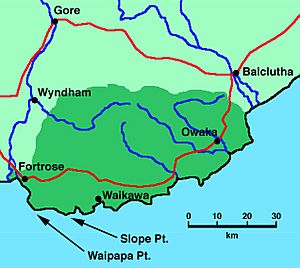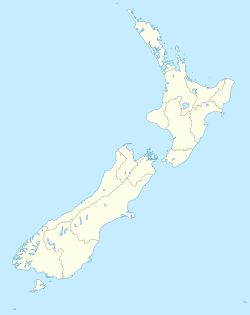Fortrose, New Zealand facts for kids
Quick facts for kids
Fortrose
|
|
|---|---|

Map of the Catlins showing location of Fortrose
|
|
| Country | New Zealand |
| Region | Southland |
| District | Southland |
Fortrose is a small place located on the very southern coast of New Zealand's South Island. It is part of the Southland region. You can find Fortrose on Toetoes Bay, right where the Mataura River meets the sea. It sits on the western edge of a beautiful area called the Catlins.
Contents
Fortrose: A Glimpse into Its Past
Fortrose has an interesting history, starting with early settlers and changing over time.
How Fortrose Began
Between 1834 and 1836, people who hunted whales lived in this area. The first plans for a town, a little west of where Fortrose is now, called it Russelltown. In the mid-1800s, the town got its current name, Fortrose. It was named by a Scottish drover (someone who moves livestock) after a place in Scotland.
Fortrose as a Port
Because Fortrose is at the mouth of the Mataura River, it became an important port. Ships would come here to move goods for the local area. In 1875, a long jetty (a pier for boats) was built, measuring about 61 meters. This helped with loading and unloading goods.
The Arrival of the Railway
However, Fortrose's importance as a port began to fade. This happened after the Tokanui Branch railway line opened. The railway reached Waimahaka in 1899 and then Tokanui in 1911. The train made it much faster to transport goods to Invercargill, which was the main city. This meant fewer ships needed to use the port at Fortrose.
Remembering Fortrose's Heroes
Many people from Fortrose bravely fought in World War I and World War II. Sadly, six people from Fortrose died in World War I, and two more died in World War II. A tall, round stone monument stands in Fortrose to remember them. It was first put up in 1922 to honor those lost in World War I. Later, the names of those who died in World War II were added to it.
Fortrose's Economy: Then and Now
The way people made a living in Fortrose has changed quite a bit over the years.
Early Economic Activities
In the 1800s, the main goods that helped the local economy were grain, logs (wood), and wool. These were important products that were shipped out from the port.
Fortrose Today
After its decline in the early 1900s, Fortrose is now starting to grow again. It is often called 'The Gateway to the Catlins'. This means it's a popular starting point for people visiting the beautiful Catlins area, which helps its economy.
Notable People from Fortrose
- Catherine Carran (a midwife and nurse from the 1860s, who passed away in 1935) and her husband William Carran (who worked as a ferryman in the 1860s).
See also
In Spanish: Fortrose (Nueva Zelanda) para niños


